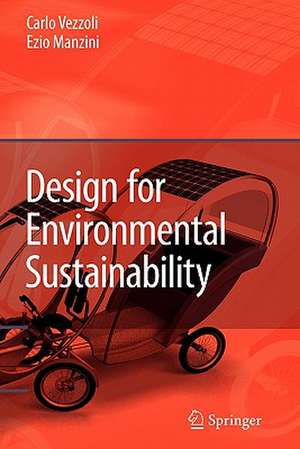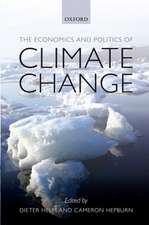Design for Environmental Sustainability
Autor Carlo Arnaldo Vezzoli, Ezio Manzinien Limba Engleză Paperback – 13 oct 2010
Preț: 477.25 lei
Preț vechi: 589.19 lei
-19% Nou
Puncte Express: 716
Preț estimativ în valută:
91.34€ • 95.39$ • 75.73£
91.34€ • 95.39$ • 75.73£
Carte tipărită la comandă
Livrare economică 07-13 februarie 25
Preluare comenzi: 021 569.72.76
Specificații
ISBN-13: 9781849967419
ISBN-10: 1849967415
Pagini: 324
Dimensiuni: 155 x 235 x 17 mm
Greutate: 0.45 kg
Ediția:Softcover reprint of hardcover 1st ed. 2008
Editura: SPRINGER LONDON
Colecția Springer
Locul publicării:London, United Kingdom
ISBN-10: 1849967415
Pagini: 324
Dimensiuni: 155 x 235 x 17 mm
Greutate: 0.45 kg
Ediția:Softcover reprint of hardcover 1st ed. 2008
Editura: SPRINGER LONDON
Colecția Springer
Locul publicării:London, United Kingdom
Public țintă
GraduateDescriere
Design
for
Environmental
Sustainabilityis
a
technical
and
operative
contribution
to
the
United
Nations
"Decade
on
Education
for
Sustainable
Development"
(2005-2014),
aiding
the
development
of
a
new
generation
of
designers,
responsible
and
able
in
the
task
of
designing
environmentally
sustainable
products.
Design for Environmental Sustainabilityprovides a comprehensive framework and a practical tool to support the design process. The book offers an organic vision of methodologies, tools and strategies for the integration of environmental requirements into product development. Possible strategies and design guidelines are highlighted, accompanied by a large selection of high-quality environmentally-aware product design case studies.
Divided into four parts, the first part covers environmental sustainability and presents the general guidelines that can be followed to reach it. The second part examines the Life Cycle Design approach and the strategies to minimise consumption of resources, select low environmental impact resources, optimise product life span, extend the life of materials, and design for disassembly. The third part presents methods and tools to evaluate the environmental impact of products (e.g., Life Cycle Assessment) and other support tools for the integration of environmental requirements into real design processes. The fourth and final part describes the historical evolution of sustainability, both in design practice and research.
Design for Environmental Sustainabilityis an important text for all students, designers and design engineers interested in product development processes.
Design for Environmental Sustainabilityprovides a comprehensive framework and a practical tool to support the design process. The book offers an organic vision of methodologies, tools and strategies for the integration of environmental requirements into product development. Possible strategies and design guidelines are highlighted, accompanied by a large selection of high-quality environmentally-aware product design case studies.
Divided into four parts, the first part covers environmental sustainability and presents the general guidelines that can be followed to reach it. The second part examines the Life Cycle Design approach and the strategies to minimise consumption of resources, select low environmental impact resources, optimise product life span, extend the life of materials, and design for disassembly. The third part presents methods and tools to evaluate the environmental impact of products (e.g., Life Cycle Assessment) and other support tools for the integration of environmental requirements into real design processes. The fourth and final part describes the historical evolution of sustainability, both in design practice and research.
Design for Environmental Sustainabilityis an important text for all students, designers and design engineers interested in product development processes.
Cuprins
Sustainability
and
Discontinuity
Products,
Contexts
and
Capacities
A
Social
Learning
Process
Life
Cycle
Design
Minimising
Resource
Consumption
Select
Low
Impact
Resources
and
Processes
Product
Lifetime
Optimisation
Extending
the
Lifespan
of
Materials
Facilitating
Disassembly
System
Design
for
Eco-efficiency
Environmental
Complexity
and
Design
Activity
Estimating
Environmental
Impact
of
Products:
Life
Cycle
Assessment
Environmentally
Sustainable
Design-orientated
Tools
Evolution
of
Sustainability
in
Design
Research
and
Practice
Recenzii
From
the
reviews:
"The authors describe life cycle assessment, including a discussion of its importance in selecting among design options. The book covers methods to evaluate environmental impacts associated with design alternatives, and addresses the historical evolution of sustainability. The volume has many references and footnotes to help the reader find additional information on key topics. … the work is generally useful for planners, engineers, and architects, and anyone concerned about environmental sustainability. Summing Up: Recommended. All collections." (L. E. Erickson, Choice, Vol. 46 (9), May, 2009)
"The authors describe life cycle assessment, including a discussion of its importance in selecting among design options. The book covers methods to evaluate environmental impacts associated with design alternatives, and addresses the historical evolution of sustainability. The volume has many references and footnotes to help the reader find additional information on key topics. … the work is generally useful for planners, engineers, and architects, and anyone concerned about environmental sustainability. Summing Up: Recommended. All collections." (L. E. Erickson, Choice, Vol. 46 (9), May, 2009)
Textul de pe ultima copertă
Design
for
Environmental
Sustainabilityis
a
technical
and
operative
contribution
to
the
United
Nations
"Decade
on
Education
for
Sustainable
Development"
(2005-2014),
aiding
the
development
of
a
new
generation
of
designers,
responsible
and
able
in
the
task
of
designing
environmentally
sustainable
products.
Design for Environmental Sustainabilityprovides a comprehensive framework and a practical tool to support the design process. The book offers an organic vision of methodologies, tools and strategies for the integration of environmental requirements into product development. Possible strategies and design guidelines are highlighted, accompanied by a large selection of high-quality environmentally-aware product design case studies.
Divided into four parts, the first part covers environmental sustainability and presents the general guidelines that can be followed to reach it. The second part examines the Life Cycle Design approach and the strategies to minimise consumption of resources, select low environmental impact resources, optimise product life span, extend the life of materials, and design for disassembly. The third part presents methods and tools to evaluate the environmental impact of products (e.g., Life Cycle Assessment) and other support tools for the integration of environmental requirements into real design processes. The fourth and final part describes the historical evolution of sustainability, both in design practice and research.
Design for Environmental Sustainabilityis an important text for all students, designers and design engineers interested in product development processes.
Design for Environmental Sustainabilityprovides a comprehensive framework and a practical tool to support the design process. The book offers an organic vision of methodologies, tools and strategies for the integration of environmental requirements into product development. Possible strategies and design guidelines are highlighted, accompanied by a large selection of high-quality environmentally-aware product design case studies.
Divided into four parts, the first part covers environmental sustainability and presents the general guidelines that can be followed to reach it. The second part examines the Life Cycle Design approach and the strategies to minimise consumption of resources, select low environmental impact resources, optimise product life span, extend the life of materials, and design for disassembly. The third part presents methods and tools to evaluate the environmental impact of products (e.g., Life Cycle Assessment) and other support tools for the integration of environmental requirements into real design processes. The fourth and final part describes the historical evolution of sustainability, both in design practice and research.
Design for Environmental Sustainabilityis an important text for all students, designers and design engineers interested in product development processes.
Caracteristici
Provides
a
comprehensive
supporting
framework
and
a
practical
tool
for
the
process
of
designing
environmentally
sustainable
products











